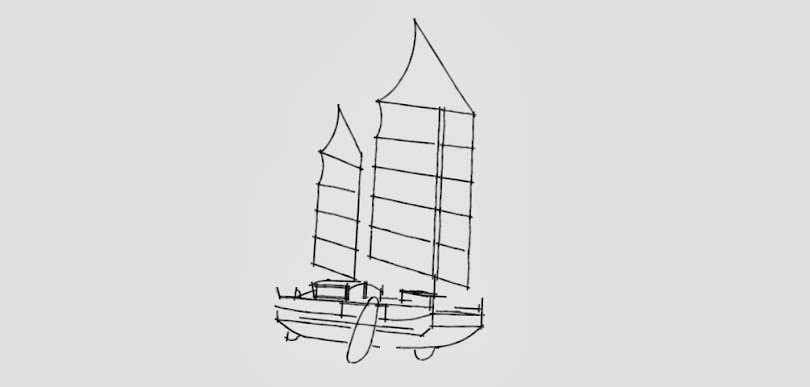 |
| Bottom first, then Sides and a band overlapping the Chine. Note the wrinkles low along the Bow Curve sides... These remained manageably small.. no 'darting' was necessary. |
Amazing Grace? Yes and No
Today was our 'coup de Grace'... we finished the installation of the Grace Ice and Water Shield underlayment for our copper plating.
Grace is a self-adhered, rubberized asphalt sheet material (comes in rolls of three foot width). A thin layer of plastic on its outer face protects the world from a sticky, gooey layer, which has the potential to fuse with plywood. This face has a peel-off layer of plasticized paper which must be removed before installation.
Our hope (mostly gratified) was that it would work well with the assemble, flip and join method we used to construct the Bottom.
Needless to say, the company nowhere suggests that Grace might be advisable for marine construction.
The Good News
When it sticks, it REALLY sticks. Especially to itself.
Once well bonded, it's like skin on the hull. Overlaps adhere even better, with high confidence of water exclusion. It seems to thoroughly gasket fasteners... withdrawing occasional screws showed them to be coated entirely along their length!
The So-So News
Application is meticulous, demanding and slow.
Any lapse of attention, or initial mis-alignment can result in a messy, wasteful sitchiAYshun. Still, we got through the whole thing with nothing worse than a little curl along an edge, here and there.
Peeling the paper was a challenge, at first. We took to scoring it at workable intervals to keep things manageable.
Touching the warm, peeled sticky-side makes ya sympathize with Bre'r Rabbit. We did better by taking small folds of the paper - plasticized layer towards the Grace - and using them as grippers along the edge.
The Not So Good News
Adhesion doesn't appear fully consistent, even when temps are in the 70degF/ 20degC range.
Initial grab drops to near nothing along with temps. In the 50degF / 10degC temps we're undergoing, we had to use a heat gun to achieve grab and bond.
Over-all handling is temperature dependant and awkwardly so.
It's stiffer when cool, so is easy to handle, but doesn't like to grab or conform to the work. When warm, it goes limp in passive resistance... conforms well, but hard to deliver, and grabs at anything along the way.
There is a fringe of un-plastic-protected tar along each edge which caused problems. It's delicate, sticky, and once it curls back and touches itself, forget it. We finally took to trimming it off before starting.
Even simple cutting is difficult in warm weather, as it sticks to the knife and drags. Possibly, wetting in mineral spirits (a solvent which works well on the stuff) would help it slide along. If possible, plan your cutting in the cool of the day, morning or evening.
And it smells toxic... the box has ominous warnings to WEAR GLOVES and WASH YOUR HANDS. Warnings in ALL-CAPS tend to be worth heeding.
Sooooo...
We're basically happy with the results, at this point. But I'm not sure I'd use it again for this application (it's excellent for bedding hardware and between dead-wood).
We're considering a last pass with a weed-burner, once the copper is on, warming it to hot-to-the-touch and whuppin' it all over with a mallet for good luck.
It was spendy and a lot of work, in retrospect.
In some ways, it wasn't much cleaner an operation than we could have managed with, say, a water emulsified asphalt, or even rubberized asphalt paint. Still, it didn't generate too much hard-to-dispose-of garbage (e.g., paint rollers, etc), and most of the off-cuts and remnants are still useful for other tasks.
Other alternatives we'd considered were tar (messy), elastomeric polyurethane paint (hard to find... 3M used to make some that we loved, but it's disappeared) and Irish felt (traditional and great to work with, but rare nowadays... what we found was prohibitively expensive to transport our way).
Grace is amazing. Time will tell if it has 'saved a wretch like we'.











